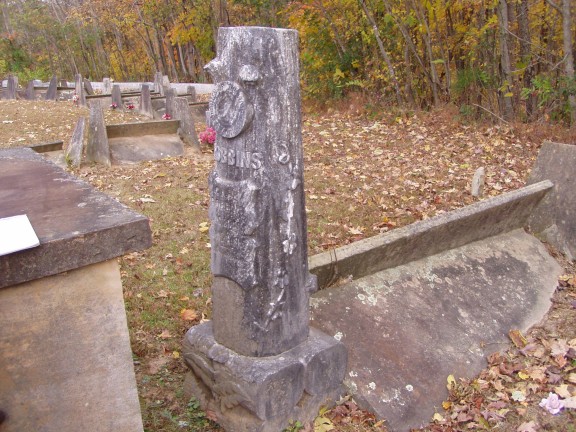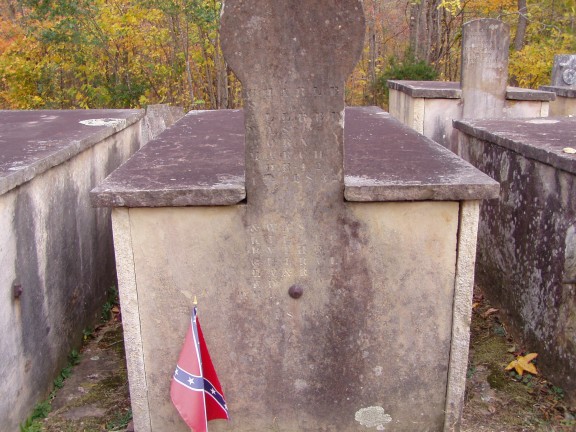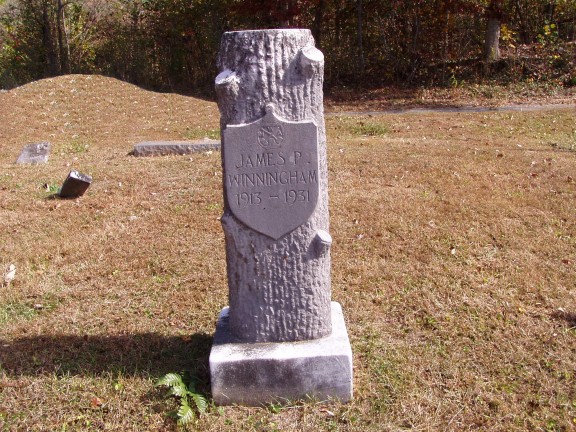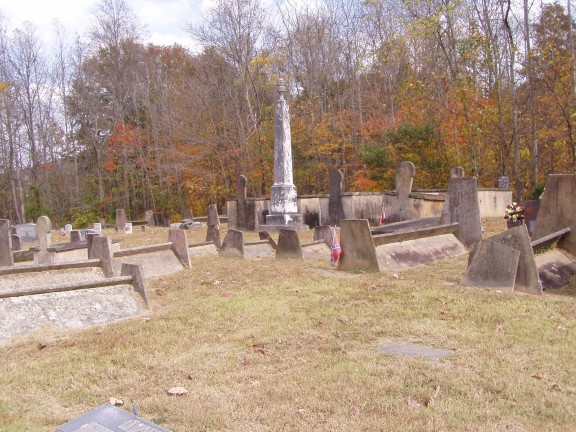Among the many activities offered by the Overton County Historical Society are day tours in the area. This past Saturday was a Fall Tour with 32 in attendance. Gentry Ledford, who was invited to serve as our official tour guide, provided many interesting stories throughout the day at various stops made in the Alpine/Bolestown area. A delicious lunch served by Rose Collins at the Miller’s Chapel Christian church was included in the trip. One of the stops not planned for on the tour turned out to be what I though was the most interesting. That was the Falling Springs cemetery. Many unusual box-type monuments are located in this cemetery along with other early tent-type gravestones. One of the most unusual tombstones found there was a granite tree stump with the words "Woodmen of the World Award." Another of the same type of marker was found in the Ferrill/Ferrell cemetery in the Ivyton community. Since no one in our group was familiar with that type of tombstone, I did some research after getting home to see what I could learn. Here’s what I found:
"Woodmen of the World is a fraternal organization based in Omaha, Nebraska, that operates a large privately held insurance company for its members. Its history includes prior to 1930 the erection across the country of numerous distinctive tombstones depicting tree stumps. The organization was founded in 1890 by Joseph Cullen Root. After hearing a sermon about "pioneer woodsmen clearing away the forest to provide for their families," he wanted to start a Society that "would clear away problems of financial security for its members." Root made a special effort to honor deceased Woodmen. He created Woodmen Memorial Day celebrated on June 6 each year and included the following statement "...to give honorable burial to our sacred dead..." Early Woodmen certificates provided for a death and a monument benefit. Gravestones were originally furnished to members free of charge. However, during the 1920s, the Society stopped providing stone markers to members when the cost of gravestones increased and cemeteries began prohibiting above-ground markers for maintenance reasons.
"Woodmen gravestones vary greatly in size and shape. Some resemble a tree stump, others a stack of cut wood. There are elaborate hand-carved monuments, simple stone markers and stake-type markers driven into the ground. Woodmen gravestones were originally intended to be a uniform design sent by the home office to local stone cutters, but not all the cutters followed the design. Some used their own interpretation of the Woodmen design which they felt was more appropriate. The result was a wide range of designs that reflected members’ personal tastes and included elements that were symbolic of Woodmen ceremonies or rituals. A tree stump, part of the Society’s logo, is the most common symbol used on gravestone designs. Many stand approximately four to five feet high. In one Kentucky cemetery, the gravestones started out as a modest Woodmen stump and grew larger with each additional burial. One gravestone is three feet wide with seven branches.

"Over the years, the once popular gravestones have become a rarity. Woodmen gravestones are still scattered in cemeteries throughout the United States. But in Laredo, Texas, there is a special section of the city cemetery reserved for Woodmen members that has been there for more than 40 years. Lodge members built an ornate concrete fence around the area and planted rose bushes for decoration. A committee from the lodge takes care of the upkeep.
"A cemetery for Woodmen members also exists near Grand Rivers, Kentucky. Located at Land Between the Lakes, a strip of Tennessee Valley Authority land between the Kentucky and Barkley Lakes is maintained by four area lodges. Many lodge members across the country take time to keep Woodmen gravestones in their area from decaying.
"Although the monument benefit is not longer included in Woodmen Life Insurance certificates, the Society does not let graves go unmarked. The same Woodmen emblem is still available, fitted with pegs, for attaching to an existing stone. Regardless of its shape or size, Woodmen gravestones serve as a lasting tribute to its members and the ideals of Woodcraft. They also serve the Society’s long standing motto that "no Woodmen shall rest in an unmarked grave."
The information shown on the Woodmen of the World marker in the Falling Springs cemetery said this: "Carl Robbins; born August 30, 1894; died June 16, 1915. Gone But Not Forgotten." According to information provided me by our County Historian Ronald Dishman, census records show that this young man’s first name was actually Carroll. Evidently the stonecutter for his marker mistakenly thought the name was "Carl." He was the son of E.G. Robbins and Nancy Reagan Robbins. He was married, and his occupation shows that he was a miner, pulling stumps. He lost his life from falling rocks while working in the mines. He was only 20 years old. Even though he died at a very young age, the fact that his grave has the granite tree stump marker tells us he had taken out a policy of insurance with Woodmen of the World. A tent-type monument also covers his grave. All these years later, these granite tree stumps continue to serve as good advertisement for insurance with Woodmen of the World.
In the next row of graves at Falling Springs, one of the box-type monuments marks the grave of a Confederate soldier and has these words inscribed:
"Charlie Allred was born March the 12th 1832 & was killed by the Guirilla and robed October 20, 1863." (The words Guerilla[s] and robbed both misspelled.) It seems that whoever wrote Charlie Allred’s epitaph wanted those who would read it many years later to understand that Charlie not only lost his life, but suffered the indignity of also being robbed as well. Not making light of the situation, but something else I wondered about was the possibility of someone not familiar with the Civil War term "Guerilla" thinking Charlie Allred had been killed and then robbed by a jungle beast. It seems the person who inscribed those words may have taken too much for granted.


